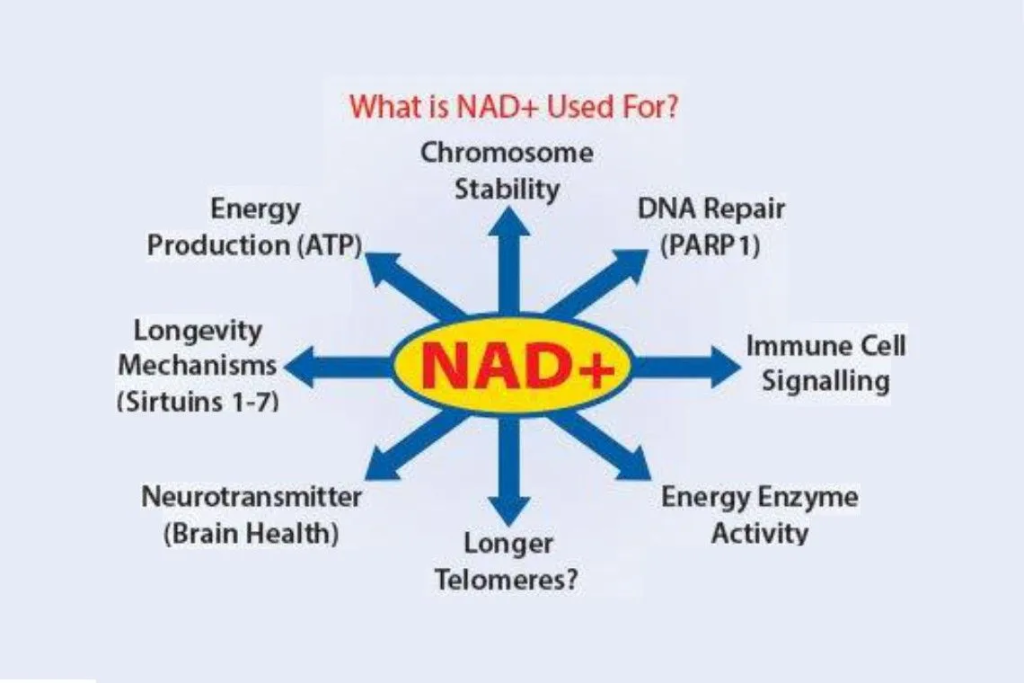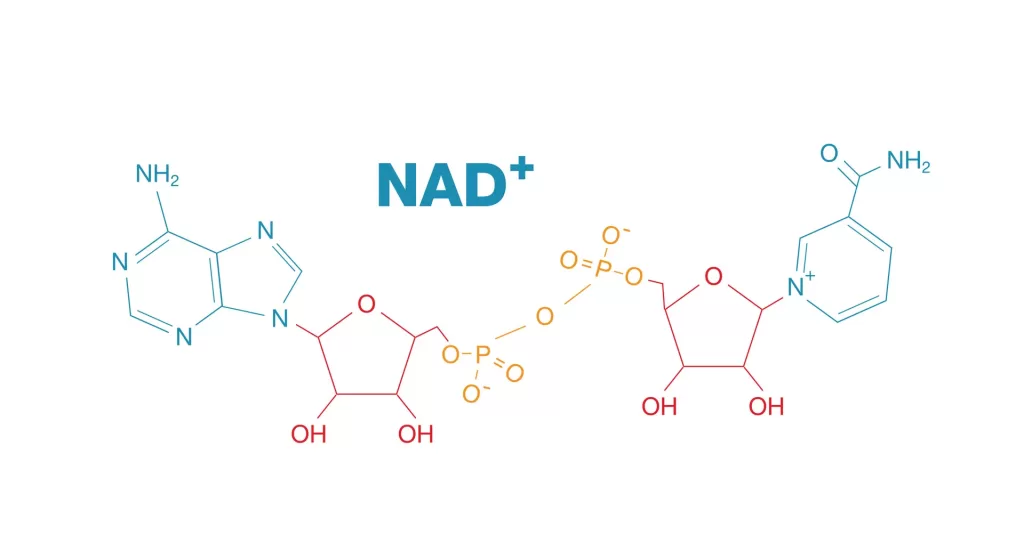What Is the Difference Between NMN and NAD+?
August 21, 2023

Do you ever find yourself lost in the world of health supplements and wondering what on earth all those acronyms mean? Well, today we're going to navigate through the alphabet soup and explore the fascinating differences between NMN and NAD+. So put on your lab coat and get ready for a scientific journey!
Understanding the Basics: NMN and NAD+
Defining NMN: A Brief Overview
Let's start with NMN, shall we? NMN, or Nicotinamide Mononucleotide, is a molecule that plays a crucial role in cellular energy production. Think of it as the spark plug that keeps your body's engine running smoothly. Without NMN, your cells would be stuck in neutral, unable to generate the energy they need to function optimally.
But what exactly is NMN? It is a nucleotide derived from ribose and nicotinamide. Nucleotides are the building blocks of DNA and RNA, the genetic material that carries the instructions for all cellular processes. NMN is synthesized in the body through a series of enzymatic reactions, starting with the conversion of nicotinamide riboside (NR) by the enzyme nicotinamide riboside kinase (NRK).
Once NMN is formed, it enters the cells and is converted into NAD+, which stands for Nicotinamide Adenine Dinucleotide. NAD+ is a coenzyme that plays a critical role in various metabolic processes, including glycolysis, the citric acid cycle, and oxidative phosphorylation. These processes are essential for the production of ATP, the main energy currency of cells.
Unpacking NAD+: What You Need to Know

Now, let's turn our attention to NAD+, or Nicotinamide Adenine Dinucleotide. This mighty molecule is not only a key player in cellular energy production but also acts as a catalyst for various enzymatic reactions in your body. In other words, it's like the master conductor of your body's orchestra, ensuring that all the cellular processes harmonize beautifully.
NAD+ is derived from NMN through a series of enzymatic reactions. Once NMN enters the cells, it is converted into NAD+ by the enzyme NMN adenylyltransferase (NMNAT). This conversion is essential for maintaining cellular energy levels and promoting overall cellular health.
But NAD+ doesn't stop there. It also serves as a substrate for enzymes called sirtuins, which play a crucial role in regulating gene expression and cellular metabolism. Sirtuins are involved in various cellular processes, including DNA repair, stress response, and longevity.
Furthermore, NAD+ is involved in redox reactions, which are essential for maintaining the balance between oxidized and reduced molecules in the body. This balance is crucial for cellular homeostasis and overall health.
In summary, NMN and NAD+ are two molecules that work hand in hand to ensure optimal cellular function. NMN acts as a precursor to NAD+, providing the necessary building blocks for its synthesis. NAD+, in turn, serves as a coenzyme and catalyst for various metabolic processes, playing a vital role in cellular energy production and overall cellular health.
The Biological Role of NMN and NAD+
The Function of NMN in the Body
Picture this: NMN, short for Nicotinamide Mononucleotide, enters your body and gets transformed into NAD+ (Nicotinamide Adenine Dinucleotide) through a series of biochemical magic tricks. NMN, a precursor to NAD+, plays a crucial role in cellular metabolism and energy production.
Once it has morphed into NAD+, this extraordinary molecule sets off a cascade of events that ultimately result in increased energy production and better overall cellular health. NAD+ acts as a coenzyme, meaning it helps enzymes carry out their functions more efficiently. It participates in redox reactions, shuttling electrons between molecules and facilitating various metabolic processes.
Furthermore, NMN has been found to activate a class of proteins called sirtuins, which are involved in regulating cellular processes such as DNA repair, gene expression, and aging. By boosting NAD+ levels, NMN enhances the activity of sirtuins, promoting cellular health and longevity.
The Role of NAD+ in Cellular Health
Now, let's shine the spotlight on NAD+. This multitasking molecule is not only vital for cellular energy but also helps repair damaged DNA, regulate gene expression, and keep those pesky free radicals in check. Talk about a superhero hiding in plain sight!
One of the primary functions of NAD+ is its involvement in cellular respiration, the process by which cells convert nutrients into energy. NAD+ acts as a key player in both glycolysis and the citric acid cycle, two essential metabolic pathways that generate ATP, the energy currency of cells.
In addition to its energy-producing role, NAD+ plays a crucial role in DNA repair. It serves as a substrate for enzymes called poly(ADP-ribose) polymerases (PARPs), which are responsible for repairing DNA damage caused by various factors, including radiation and oxidative stress. By providing the necessary building blocks for DNA repair, NAD+ helps maintain genomic stability and prevents the accumulation of mutations.
Moreover, NAD+ is involved in regulating gene expression through a process called epigenetic modification. It serves as a co-substrate for enzymes called sirtuins, which remove acetyl groups from histone proteins, thereby altering the structure of chromatin and influencing gene activity. This epigenetic regulation mediated by NAD+ and sirtuins plays a crucial role in various biological processes, including aging, metabolism, and stress response.
Lastly, NAD+ acts as an antioxidant, helping to neutralize harmful free radicals that can damage cells and contribute to aging and disease. It does so by participating in redox reactions, accepting electrons from reactive oxygen species (ROS) and preventing them from causing oxidative damage to cellular components.
In conclusion, NMN and its derivative NAD+ are not only involved in energy production but also play diverse roles in maintaining cellular health. From activating sirtuins and promoting DNA repair to regulating gene expression and combating oxidative stress, these molecules are essential for the proper functioning and longevity of our cells.
The Connection Between NMN and NAD+
When it comes to understanding the fascinating relationship between NMN and NAD+, it's important to delve into the intricate details of how NMN converts into NAD+. This process is where things truly get interesting and showcase the remarkable capabilities of these molecules.
How NMN Converts into NAD+
Imagine NMN as the essential building block, the raw material that your body requires to manufacture NAD+. Without a healthy supply of NMN, your NAD+ levels could dip, leaving your cells feeling like deflated balloons. Just like a dedicated factory worker, NMN tirelessly churns out supplies to keep the production line of NAD+ running smoothly.
But what exactly does NAD+ do? Well, it plays a crucial role in numerous cellular processes, including energy production, DNA repair, and maintaining proper cell function. Without sufficient levels of NAD+, these vital processes can be compromised, leading to various health issues.
The Interplay Between NMN and NAD+ in Aging
As we gracefully age, our NMN and NAD+ levels naturally decline, much like the slow fade of a summer sunset. This decline can have significant implications for our overall health and well-being. It affects various aspects of our body, including metabolism, cognitive function, and even our body's ability to repair itself.
However, there is no need to despair, as scientists are eagerly exploring the potential of boosting NMN and NAD+ levels to potentially reverse the effects of aging. By replenishing these essential molecules, it is believed that we may be able to rejuvenate our cells and restore youthful vitality.
Research in this field is rapidly advancing, with promising findings suggesting that increasing NMN and NAD+ levels could have profound effects on aging-related conditions. From enhanced cognitive function to improved metabolic health, the potential benefits are truly remarkable.
So, while the connection between NMN and NAD+ is undoubtedly intriguing, it is the potential implications for aging and overall health that truly captivate the scientific community. With further research and exploration, we may unlock the secrets to maintaining youthful vigor and vitality for longer.
The Differences Between NMN and NAD+

Comparing the Bioavailability of NMN and NAD+
Now, let's talk about how these two molecules differ. When it comes to bioavailability, NMN takes the crown. It has excellent absorption rates, making it more readily available for your body to use compared to NAD+. This means that when you take NMN as a supplement, your cells can quickly gobble it up like a hungry Pac-Man, ready to put it to use in various metabolic processes.
But what exactly does bioavailability mean? Well, it refers to the amount of a substance that enters the bloodstream and is available for the body to utilize. In the case of NMN, its high bioavailability ensures that a significant portion of the supplement reaches its target cells, allowing for optimal effectiveness.
On the other hand, NAD+ has lower bioavailability compared to NMN. This means that when you take NAD+ as a supplement, a smaller percentage of it is absorbed by your body, resulting in a reduced amount available for cellular processes. While NAD+ still plays a crucial role in various physiological functions, its lower bioavailability may limit its potential benefits.
The Impact of NMN and NAD+ on Longevity
Ah, the eternal quest for the fountain of youth! Both NMN and NAD+ have shown promise in the longevity department, but NMN steals the show once again. By boosting NAD+ levels, NMN helps activate sirtuins, a group of proteins associated with increased lifespan.
Sirtuins, often referred to as the "guardians of the genome," play a vital role in regulating cellular processes such as DNA repair, inflammation, and metabolism. As we age, the activity of sirtuins tends to decline, which can contribute to the development of age-related diseases and a decrease in overall health.
However, by increasing NAD+ levels through NMN supplementation, we can potentially enhance sirtuin activity and promote longevity. This means that NMN might be worth a closer look if you're interested in aging like a fine wine and outliving your old high school yearbook predictions.
It's important to note that while NMN shows promise in the field of longevity, research is still ongoing, and more studies are needed to fully understand its effects on human health and lifespan. Nevertheless, the potential of NMN in supporting healthy aging is an exciting area of scientific exploration.
In conclusion, when comparing the bioavailability of NMN and NAD+, NMN takes the lead with its excellent absorption rates. Additionally, NMN's ability to boost NAD+ levels and activate sirtuins makes it a promising candidate for promoting longevity. However, further research is necessary to fully uncover the potential benefits and mechanisms of NMN supplementation. So, if you're considering incorporating NMN into your wellness routine, it's always a good idea to consult with a healthcare professional to ensure it aligns with your individual needs and goals.
The Potential Health Benefits of NMN and NAD+
Exploring the Health Benefits of NMN
So, what are the potential health benefits of NMN? Buckle up because it's an impressive list! NMN has been studied for its positive effects on cardiovascular health, brain function, immune system support, and even muscle endurance. It's like a Swiss Army knife for your well-being!
Understanding the Health Benefits of NAD+
And let's not forget about NAD+! This versatile molecule has also shown promise in various areas, including cellular rejuvenation, DNA repair, and even protecting against age-related neurodegenerative diseases. Talk about having your back, both inside and out!
Conclusion
So, dear readers, there you have it – the delightful differences between NMN and NAD+. From their roles in cellular energy production to their potential impact on longevity and health, these molecules are truly fascinating. Whether you're considering NMN, NAD+, or both as part of your wellness journey, remember that any decisions regarding your health should be made in consultation with a healthcare professional. Now, go forth and embrace the mysteries of NMN and NAD+ with newfound zest!

 Back to Blog
Back to Blog